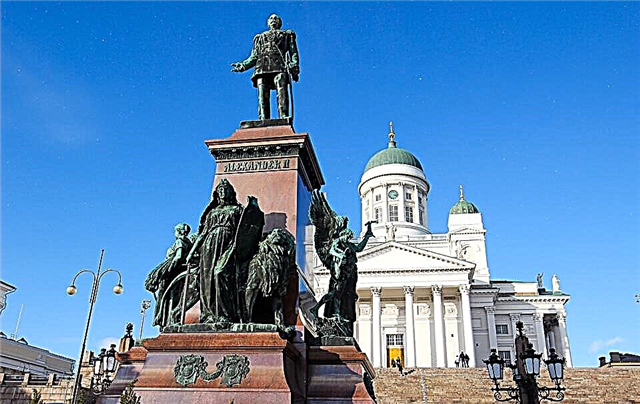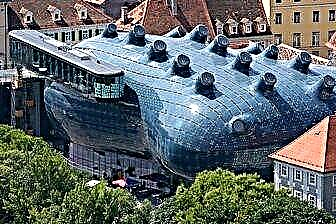Address: Russia, Yaroslavl region, Yaroslavl, st. Svobody, 2a
Start of construction: 1658 year
Completion of construction: 1659 year
Coordinates: 57 ° 37'31.5 "N 39 ° 53'07.1" E
Cultural heritage site of the Russian Federation
Content:
An unusual double building in the very center of old Yaroslavl invariably attracts the attention of tourists. Built in the Middle Ages, it is one of the oldest surviving architectural monuments of the city. In terms of its size and thickness of the walls, the tower can compete with the most powerful medieval buildings of the Russian state.
The history of the defensive tower
Ancient Yaroslavl, up to the 16th century, was entirely made of wood. But in the 17th century, large stone construction began in the city. The Kremlin and the Earthen City were equipped with sixteen powerful defensive towers, four of which were passable and played the role of city gates. All the towers monitored the borders of Yaroslavl, and each contained a military garrison capable of resisting in the event of an enemy attack. Only two of these towers have survived to this day - Volzhskaya (Arsenalnaya) and Vlasyevskaya (Znamenskaya).

Vlasyevskaya tower and Znamenskaya church
The travel Vlasyevskaya (Znamenskaya) tower was located on the line of fortifications that ran along modern Pervomayskaya Street. It was considered the main gateway to the city, and from here the road to Uglich began. Now near the tower there is a square named after the founder of the first Russian professional theater Fyodor Grigorievich Volkov. Until 1917, the square was called Vlasyevskaya, and later, until 1937 - Teatralnaya. Historians, not without reason, consider this place to be the most ancient part of Yaroslavl.
In the 60s of the 17th century, a chapel was added to the tower, which was rebuilt into a church two centuries later. Interestingly, during the reign of Peter I, those who passed through the tower gates were charged taxes for unshaven beards and wearing clothes of an old, not European style. There is information that in 1711 360 rubles were collected from the city treasury for 73 beards. At the end of the 18th century, when the city began to be built up according to a regular plan, the old defensive structures lost their original function. Some of them were dismantled, but the fate of the Vlasyevskaya tower was happier - it survived.
Until 1980, the architectural complex of the tower and the temple was closed on three sides by buildings that belonged to the Yaroslavl State University and the hotel, which was once owned by the merchant of the first guild, Rafail Ivanovich Kokuev. Then the hotel building was demolished, and the square with the Vlasyevskaya tower became as we know it today.
Vlasyevskaya tower
Before the brick tower, erected in 1658-1659, there was a wooden fortification that had existed here since the middle of the 16th century. This old tower burned down during the largest fire in Yaroslavl, which happened in 1658. It got its name from one of the oldest parishes in Yaroslavl - Vlasyevsky, which at that moment was outside the city limits, that is, behind the Zemlyanoy Val.
The brick tower at the base has the shape of a square and rises in four tiers. The thickness of its walls in places reaches six meters. In the old days, the tower was equipped with a bridge over the Uglich road and a diversion arrow (zhab), which were dismantled in 1820. The large tent that crowned it and the alarm bell "perished" in a fire in 1711.
In the lower tower tier there is a gate for passage. Initially, lowering iron gratings (gers) were fixed in them, the slits from which have survived to this day. On the second and third tiers, narrow loopholes were made for combat from muskets and a brewhouse, from which enemies could be poured with boiling resin. The top of the tower was crowned with dovetail teeth.

Vlasyevskaya tower
At the end of the 18th century, a house was added to the fortification from the south where Count Saltykov lived. After some time, this building was bought by the former serf count - the wealthy merchant Sobolev. He began to use it for warehouses. The Sobolevs carried on a large wine trade and sold their wares in Yaroslavl, both capitals and at the fair in Nizhny Novgorod. This house still stands today, and it houses the Faculty of Economics of the City University named after P.G. Demidov.
At the very beginning of the 19th century, when the fortifications along the Zemlyanoy rampart were actively being dismantled, the local merchant R.I.Kokuev invested in the construction of a two-story hotel, which with its southern facade was close to the old Vlasyevskaya tower. This hotel was considered one of the best in the city, was very popular and had a bakery on the ground floor, shops selling sewing machines, linen and toys, a bookstore, a dye shop and a hairdresser.
History has also preserved facts about the attempt to demolish the famous Yaroslavl tower. Back in the 1780s, the governor-general of the city Aleksey Petrovich Melgunov wanted to disassemble it. He even ordered the use of brick from the tower for new urban development. But Yaroslavl merchants opposed this decision. They collected money, bought the brick and saved the tower from destruction. The second attempt to demolish the tower took place in the 20s of the 19th century. This proposal was made by the capital's architects who came to approve the next urban planning plans for Yaroslavl. But the old tower was defended by the local authorities and, in particular, by the city governor Gavriil Gerasimovich Politkovsky.
In 1883, a fifth tier was built over the old defensive building, intended for a large capacity of 16 thousand buckets of water, turning it into a water tower. The tank was closed from above with a decorative turret, which is still visible today. So the Vlasyevskaya tower acquired an unusual North-Italian look and became an integral part of the created Yaroslavl water supply system. Water from the Volga coast was fed into sedimentary tanks, and then it was fed through a cast-iron water supply to a tank on the Vlasyevskaya tower. The water supply at that time stretched for 5 km and provided water to about 500 houses from 7000 private households that existed in the city.
Temple in honor of the icon of the Mother of God "Sign"
When the tower was being built, the icon of the Mother of God "Sign" was painted on its eastern wall, and the icon of the Savior on the western wall. A wooden staircase was laid to the wall icon of the Mother of God. This image soon became famous among the inhabitants of the city as miraculous.
An unusual church was added to the Vlasyevskaya church on the east side in the 60s of the 17th century. Initially, it was a wooden chapel, consecrated in honor of the revered Orthodox icon and attributed to the Afanasyevsky monastery. In 1673, it was decided to replace the wooden structure with a stone one. To prevent the foundation from sagging from the rise of groundwater, it was carefully reinforced with driven piles. The construction was long and took 6 years. The new chapel was consecrated only in 1679.

Church of the Sign
Later, the temple building was rebuilt several times (1779, 1861, 1864), and finally, in 1897, during the reconstruction, carried out by the architect Alexander Alexandrovich Nikiforov, it acquired the forms we know today and was decorated with ornate arches and carved cornices. Every time the construction work was sponsored by the wealthy merchant families of Yaroslavl - the Olovyanishnikovs, Shipulins and Sobolevs.
The church is made in the second tier, above the passage of the tower. It is made of bricks in the pseudo-Russian style, in which features of Art Nouveau and Byzantine traditions are mixed. This temple has one onion dome and is plastered along the facades. In the 1990s, the scaly cover of the dome was replaced by a smooth gilding.
The current state of the architectural complex
Today the tower has the status of a cultural heritage site at the federal level, and the church - at the regional level. Until recently, the Yunost film studio was located inside the buildings, and now they belong to the Yaroslavl University. According to local art critics, the interiors of the Vlasyevskaya tower are very reminiscent of the interior of the Spasskaya tower of the Moscow Kremlin.
How to get there
The old fortification complex is located in Yaroslavl on Svoboda Street, 2A.
By car. The federal highway M8 leads from Moscow to Yaroslavl. Within the city limits, it is called Moskovsky Prospekt. You need to cross the Korotosl River along it. The Vlasyevskaya Tower is located on the left along the course, before reaching Volkov Square.
By train. From Moscow to Yaroslavl, express train trains reach in 3 hours 16 minutes. The journey by regular train takes from 4 to 5.5 hours. From the Moskovsky railway station in Yaroslavl, the distance to the architectural complex of the Vlasyevskaya tower is 3.3 km. You can walk here or take a bus.











